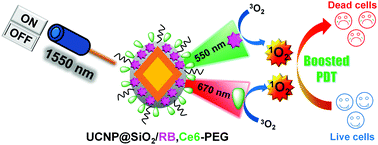1550 nm excitation-responsive upconversion nanoparticles to establish dual-photodynamic therapy against pancreatic tumors†
Abstract
The second near-infrared biological window b (NIR-IIb, 1500–1700 nm) is recently considered as the promising region for deeper tissue penetration. Herein, a nanocarrier for 1550 nm light-responsive dual-photodynamic therapy (PDT) is developed to efficiently boost singlet oxygen (1O2) generation. The dual-photosensitizers (PSs), rose bengal (RB) and chlorin e6 (Ce6), are carried by the silica-coated core–shell LiYbF4:Er@LiGdF4 upconversion nanoparticles (UCNPs), forming UCNP/RB,Ce6. Following 1550 nm laser irradiation, the upconversion emission of UCNP/RB,Ce6 in both green (∼550 nm) and red (∼670 nm) colors is fully utilized to activate RB and Ce6, respectively. The simultaneous triggering of dual-PS generates an abundant amount of 1O2 resulting in boosted PDT efficacy. This dual-PDT nanocarrier presents an enhanced anticancer effect under single dose treatment in comparison with the single-PS ones from in vitro and in vivo treatments. The marriage between the boosted dual-PDT and 1550 nm light excitation is anticipated to provide a new avenue for non-invasive therapy.

- This article is part of the themed collections: 2021 Journal of Materials Chemistry B most popular articles and Journal of Materials Chemistry B Lunar New Year collection 2022


 Please wait while we load your content...
Please wait while we load your content...